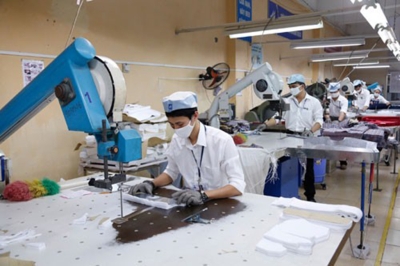


Textile industry under pressure Industrial Revolution 4.0
10-02-2018
During the Industrial Revolution 4.0, when the level of automation is pushed up to the maximum, the Vietnam Textile and Apparel industry will lose the advantage of low cost laborers and skilled workers. Many people worry that Vietnam textile will be difficult because a lot of orders will be back to the developed countries. How did the Industrial Revolution really affect the textile industry in Vietnam?

Manufacture garment for export at Garment Corporation 10. Photo: Nhat Nam
With acumen and flexibility, in 10 years, the textile sector, Vietnam has picked up a shift of world manufacturing to Vietnam, rose strongly with a growth rate more than ten times. In 2017, despite many difficulties, the textile and garment industry has gradually stabilized, surpassing the export turnover of more than US $ 31 billion, growing at over 10.2%. goals.
According to Le Tien Truong, General Director of Vietnam Textile and Garment Group, the growth of exports of Vietnam Textile and Garment sector is more meaningful when the export turnover of this item in the main textile export countries the world is still falling. In addition to maintaining good growth in major export markets such as the US, the EU, Japan and the Republic of Korea, the textile and garment industry has made great strides in diversifying markets and making a breakthrough. In other markets such as China, Russia, Cambodia ... In addition to the traditional textiles products, the value-added items such as fabric, fiber, geotextile, textile accessories also have growth. very good.
However, before the new development trend of the world economy, when the Industrial Revolution began to take place 4.0, with a high degree of automation, using robots, inevitable labor force will decline. Moreover, the stages in the production process, circulation are connected with each other through the internet, so the cost of management, design is also significantly reduced. Thus, the advantage of low-cost labor will no longer, leading to the risk of textile production will move back to the developed countries.
At this point, Vietnam's textile and garment stands in the context of stranded advantage, when Vietnam's low labor costs are not comparable to countries such as Bangladesh and Cambodia, but the technology is not as high as the countries develop. In that context, if there is no rational transformation strategy, wrong choice of investment, Vietnam textile and garment will have great obstacles in maintaining the development and existence.
General Director Le Tien Truong analyzes that in order to achieve the objective of further development, Vietnam's textile and garment industry must first increase its labor productivity by technology, creating a competitive advantage. In particular, it must invest in the world's leading technology, reducing the amount of labor per product. To do this, textile enterprises can increase productivity, shorten delivery time, along with increasing salary for employees, attracting staff ...
In fact, in recent years, Vietnam's textile and garment exports have been increasing at $ 3 billion a year. To achieve this impressive growth, half of them rely on new investment in manufacturing plants. But with the investment in modern technology, businesses do not need to open new factories, continue to use the same workforce but still grow by productivity. Moreover, when the industry applies the management technology that connects all stages of production, it also reduces inventory costs. Such information connectivity enables parties to use each other's products in the fastest production chain, optimizing transit times, and reducing overall costs for the entire production process.
At this moment, the transition to modern technology is the right way for the textile industry to keep orders and jobs for workers. However, in order to catch up to the Industrial Revolution 4.0, needed the support policy of the State through tax breaks, loan interest rate incentives for businesses to promote investment, especially early invest in green production, clean.
Source vinatax